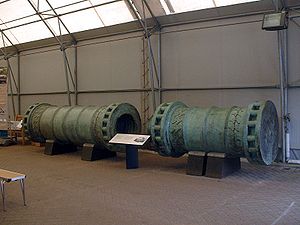Dardanelles Gun
| Basillica | |
|---|---|
 Dismantled Dardanelles Gun at Fort Nelson, Hampshire, overlooking Portsmouth | |
| Type | Bombard |
| Service history | |
| Used by | Ottoman Empire |
| Wars | Dardanelles operation |
| Production history | |
| Designer | Munir Ali[1] |
| Produced | 1464[1] |
| Specifications | |
| Mass | 17,069 kg (37,631 lb)[1] |
| Barrel length | 518 cm (204 in)[2] |
| Diameter | 1,054 mm (41.5 in) |
| Caliber | 635 mm (25.0 in)[1][3] |
| Action | slow match |
| Elevation | none |
| Traverse | none |
| Feed system | muzzle loader |
The Dardanelles Gun or Great Bronze Gun[1] (Turkish: Şahi topu or simply Şahi) is a 15th-century siege cannon, specifically a super-sized bombard, which saw action in the 1807 Dardanelles operation.[2] It was built in 1464 by Ottoman military engineer Munir Ali and modelled after the Basilic, the bombard crafted by Orban that was used for the Ottoman siege of Constantinople in 1453.
History
[edit]The Dardanelles Gun was cast in bronze in 1464 by Munir Ali with a weight of 17 tonnes and a length of 5.18 m (17.0 ft), being capable of firing stone balls of up to 0.635 m diameter (25.0 in). The powder chamber and the barrel are connected by the way of a screw mechanism, allowing easier transport of the unwieldy device.
Such super-sized bombards had been employed in Ottoman warfare[4] and in Western European siege warfare since the beginning of the 15th century.[5] According to Gábor Ágoston, the technology could have been introduced from other Islamic countries which had earlier used cannons or from Europe.[6] The Ottoman army successfully deployed large bombards at the siege of Salonica in 1430, and against the Hexamilion wall at the Isthmus of Corinth in 1446.[4]
At the siege of Constantinople in 1453, the Ottomans employed several cannons, anywhere from 12 to 62. They were built at foundries that employed Turkish cannon founders and technicians, most notably Saruca, in addition to at least one foreign cannon founder, Orban. Most cannons at the siege were built by Ottoman engineers, including a large bombard by Saruca, while one cannon was built by Orban, who also contributed a large bombard.[7][8] Orban was from Brassó, Kingdom of Hungary, before working for the Ottoman army in 1453. Ali's piece is assumed to have closely followed the outline of the large bombards used at the siege of Constantinople.[9]
Along with other huge cannons, the Dardanelles Gun was still present for duty more than 340 years later in 1807, when a Royal Navy force appeared and commenced the Dardanelles Operation. Turkish forces loaded the ancient relics with propellant and projectiles, then fired them at the British ships. The British squadron suffered 28 casualties from this bombardment.[2] A spherical round made of granite, 63 centimetres (25 in) of diameter, and a density of 2600kg/cubic metre, has a weight of 340 kilograms (750 lb).
The gun was being considered for scrapping by 1850 but this was held off after John Henry Lefroy tried to get it added to the collection of Britain's Royal Military Depository.[10] In 1866, on the occasion of a state visit, Sultan Abdulaziz gave the Dardanelles Gun to Queen Victoria as a present.[9] It became part of the Royal Armouries collection and was displayed to visitors at the Tower of London. In 1989, it was moved to Fort Nelson, Hampshire, overlooking Portsmouth.[11][10]
See also
[edit]Notes
[edit]- ^ a b c d e "Gun - Turkish Bombard - 1464". Royal Armouries. Retrieved 2 October 2024.
- ^ a b c Schmidtchen 1977b, p. 228.
- ^ ffoulkes 1930, p. 224.
- ^ a b Ágoston, Gábor (2005). Guns for the Sultan: Military Power and the Weapons Industry in the Ottoman Empire. Cambridge University Press. pp. 64–6. ISBN 9780521843133.
- ^ Schmidtchen 1977a, pp. 153–157.
- ^ Ágoston 2016, pp. 296–297.
- ^ Steele, Brett D. (2005). The Heirs of Archimedes: Science and the Art of War Through the Age of Enlightenment. MIT Press. p. 106. ISBN 9780262195164.
- ^ Ágoston 2016, pp. 301–304.
- ^ a b Schmidtchen 1977b, p. 226.
- ^ a b Impey, Edward, ed. (2022). Treasures of the Royal Armouries A Panoply of Arms. Royal Armouries Museum. p. 80. ISBN 9781913013400.
- ^ "Geometry of War – Pg. 6" (PDF). Archived from the original (PDF) on 15 June 2011. Retrieved 7 September 2007.
Sources
[edit]- ffoulkes, Charles (July 1930). "The 'Dardanelles' Gun at the Tower". The Antiquaries Journal. 10 (3): 217–227. doi:10.1017/S0003581500041032.
- Schmidtchen, Volker (1977a). "Riesengeschütze des 15. Jahrhunderts. Technische Höchstleistungen ihrer Zeit". Technikgeschichte. 44 (2): 153–157.
- Schmidtchen, Volker (1977b). "Riesengeschütze des 15. Jahrhunderts. Technische Höchstleistungen ihrer Zeit". Technikgeschichte. 44 (3): 213–237.
- Ágoston, Gábor (2016) [1994]. "Ottoman Artillery and European Military Technology in the Fifteenth and Seventeenth Centuries". In Hammer, Paul E. J. (ed.). Warfare in Early Modern Europe 1450–1660. Routledge. pp. 289–322. doi:10.4324/9781315234342. ISBN 978-0-7546-2529-2.
External links
[edit]![]() Media related to Dardanelles Gun at Wikimedia Commons
Media related to Dardanelles Gun at Wikimedia Commons
